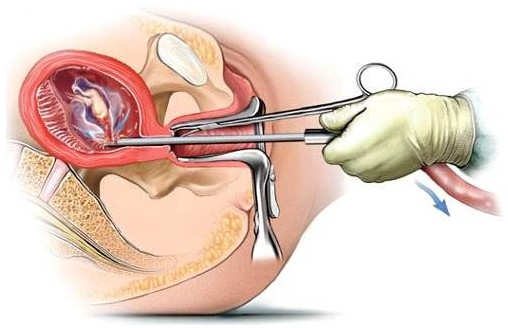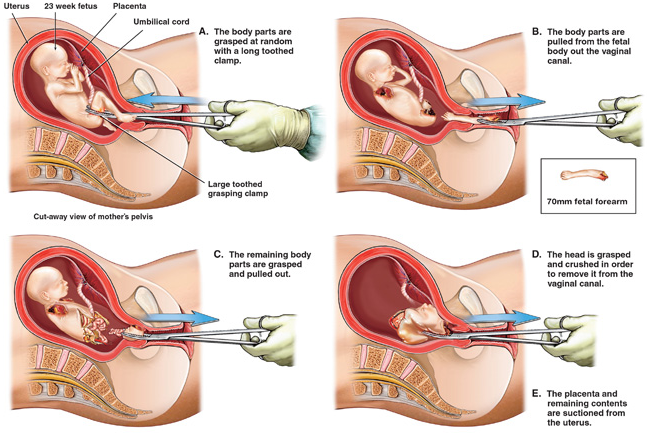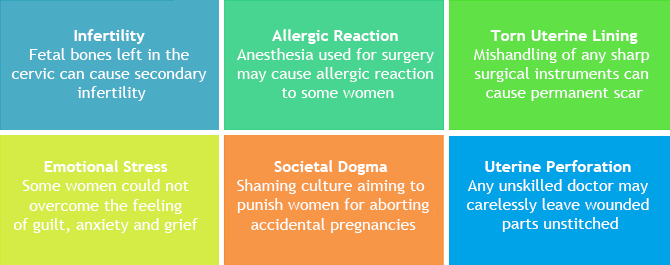1. Aspiration & Suction
Aspiration is a surgical abortion procedure performed during the first 6 to 14 weeks gestation. It is also referred to as suction aspiration, suction curettage or vacuum aspiration. Your doctor will give you medication for pain relief and possibly sedation. It is the most commonly preferred procedure compared to other methods.
 rA tenaculum (surgical instrument with long handles and a clamp at the end) is used to hold the cervix in place for the cervix to be dilated by absorbant rods that vary in size. The rods may also be put in a few days prior to the procedure. When the cervix is wide enough, a cannula, which is a long plastic tube connected to a suction device, is inserted into the uterus to suction out the fetus and placenta. The procedure usually lasts 10-15 minutes, but recovery can require staying at the clinic for a few hours. Your doctor will also give you antibiotics to help prevent infection.Risks
rA tenaculum (surgical instrument with long handles and a clamp at the end) is used to hold the cervix in place for the cervix to be dilated by absorbant rods that vary in size. The rods may also be put in a few days prior to the procedure. When the cervix is wide enough, a cannula, which is a long plastic tube connected to a suction device, is inserted into the uterus to suction out the fetus and placenta. The procedure usually lasts 10-15 minutes, but recovery can require staying at the clinic for a few hours. Your doctor will also give you antibiotics to help prevent infection.Risks
Common side effects of the procedure include cramping, nausea, sweating, and feeling faint. Less frequent side effects include possible heavy or prolong bleeding, blood clots, damage to the cervix and perforation of the uterus. Infection due to retained products of conception or infection caused by an STD or bacteria being introduced to the uterus can cause fever, pain, abdominal tenderness and possibly scar tissue.
Aspiration is a surgical abortion procedure performed during the first 6 to 14 weeks gestation. It is also referred to as suction aspiration, suction curettage or vacuum aspiration. Your doctor will give you medication for pain relief and possibly sedation. It is the most commonly preferred procedure compared to other methods.
 rA tenaculum (surgical instrument with long handles and a clamp at the end) is used to hold the cervix in place for the cervix to be dilated by absorbant rods that vary in size. The rods may also be put in a few days prior to the procedure. When the cervix is wide enough, a cannula, which is a long plastic tube connected to a suction device, is inserted into the uterus to suction out the fetus and placenta. The procedure usually lasts 10-15 minutes, but recovery can require staying at the clinic for a few hours. Your doctor will also give you antibiotics to help prevent infection.Risks
rA tenaculum (surgical instrument with long handles and a clamp at the end) is used to hold the cervix in place for the cervix to be dilated by absorbant rods that vary in size. The rods may also be put in a few days prior to the procedure. When the cervix is wide enough, a cannula, which is a long plastic tube connected to a suction device, is inserted into the uterus to suction out the fetus and placenta. The procedure usually lasts 10-15 minutes, but recovery can require staying at the clinic for a few hours. Your doctor will also give you antibiotics to help prevent infection.RisksCommon side effects of the procedure include cramping, nausea, sweating, and feeling faint. Less frequent side effects include possible heavy or prolong bleeding, blood clots, damage to the cervix and perforation of the uterus. Infection due to retained products of conception or infection caused by an STD or bacteria being introduced to the uterus can cause fever, pain, abdominal tenderness and possibly scar tissue.
2. Dilation & Curettage (D&C)
Dilation and curettage (D&C) is a procedure to remove tissue from inside your uterus. Doctors perform dilation and curettage to fix certain uterine conditions — such as heavy bleeding — or to clear the uterine lining after an incomplete miscarriage or failed abortion. The doctor uses small instruments or a medication to open (dilate) your cervix — the lower, narrow part of your uterus.
Dilation and curettage (D&C) is a procedure to remove tissue from inside your uterus. Doctors perform dilation and curettage to fix certain uterine conditions — such as heavy bleeding — or to clear the uterine lining after an incomplete miscarriage or failed abortion. The doctor uses small instruments or a medication to open (dilate) your cervix — the lower, narrow part of your uterus.
Risks
Dilation and curettage is usually very safe, and complications are rare. However, there are possible risks:
 Infection after a D&C procedure, but rare
Infection after a D&C procedure, but rare
 Perforation of the uterus. Most perforations heal on their own
Perforation of the uterus. Most perforations heal on their own
 Torn cervix after D&C, but the wound can be fixed with stitches
Torn cervix after D&C, but the wound can be fixed with stitches
 Bleeding that’s heavy enough that you need to change pads every hour
Bleeding that’s heavy enough that you need to change pads every hour
 Light bleeding that lasts longer than two weeks
Light bleeding that lasts longer than two weeks
 Cramps lasting more than 48 hours
Cramps lasting more than 48 hours
 Pain that gets worse instead of better
Pain that gets worse instead of better
 Foul-smelling discharge from the vagina
Foul-smelling discharge from the vagina
 Fever
Fever
Dilation and curettage is usually very safe, and complications are rare. However, there are possible risks:
3. Dilation & Evacuation (D&E)
Dilation and evacuation is an emergency surgical procedure performed after 14 weeks gestation to save a woman’s life due to early fetal death in the womb which will endanger the mother. In most cases, 24 hours prior to the actual procedure, your abortion provider will insert laminaria or a synthetic dilator inside your cervix. When the procedure begins the next day, your abortion provider will use a tenaculum to keep the cervix and uterus in place and cone-shaped rods of increasing size are used to continue the dilation process.
Dilation and evacuation is an emergency surgical procedure performed after 14 weeks gestation to save a woman’s life due to early fetal death in the womb which will endanger the mother. In most cases, 24 hours prior to the actual procedure, your abortion provider will insert laminaria or a synthetic dilator inside your cervix. When the procedure begins the next day, your abortion provider will use a tenaculum to keep the cervix and uterus in place and cone-shaped rods of increasing size are used to continue the dilation process.

Risks
Common side effects include nausea, bleeding and cramping which may last for two weeks following the procedure. Although rare, the following are additional risks related to dilation and evacuation: damage to uterine lining or cervix, perforation of the uterus, infection, and blood clots. Contact your healthcare provider immediately if your symptoms persist or worsen.
Common side effects include nausea, bleeding and cramping which may last for two weeks following the procedure. Although rare, the following are additional risks related to dilation and evacuation: damage to uterine lining or cervix, perforation of the uterus, infection, and blood clots. Contact your healthcare provider immediately if your symptoms persist or worsen.
Other Risks of Surgical Abortion


